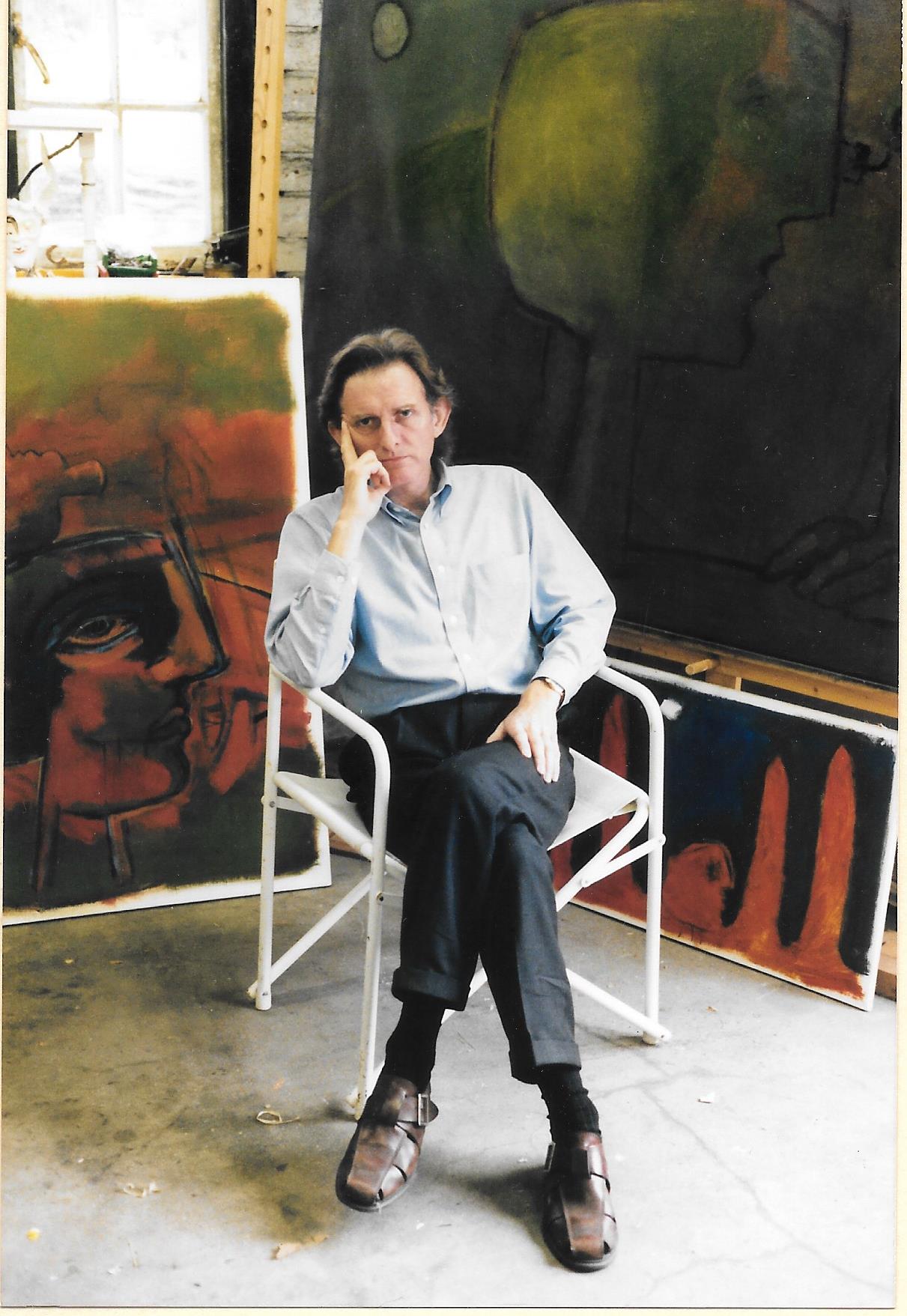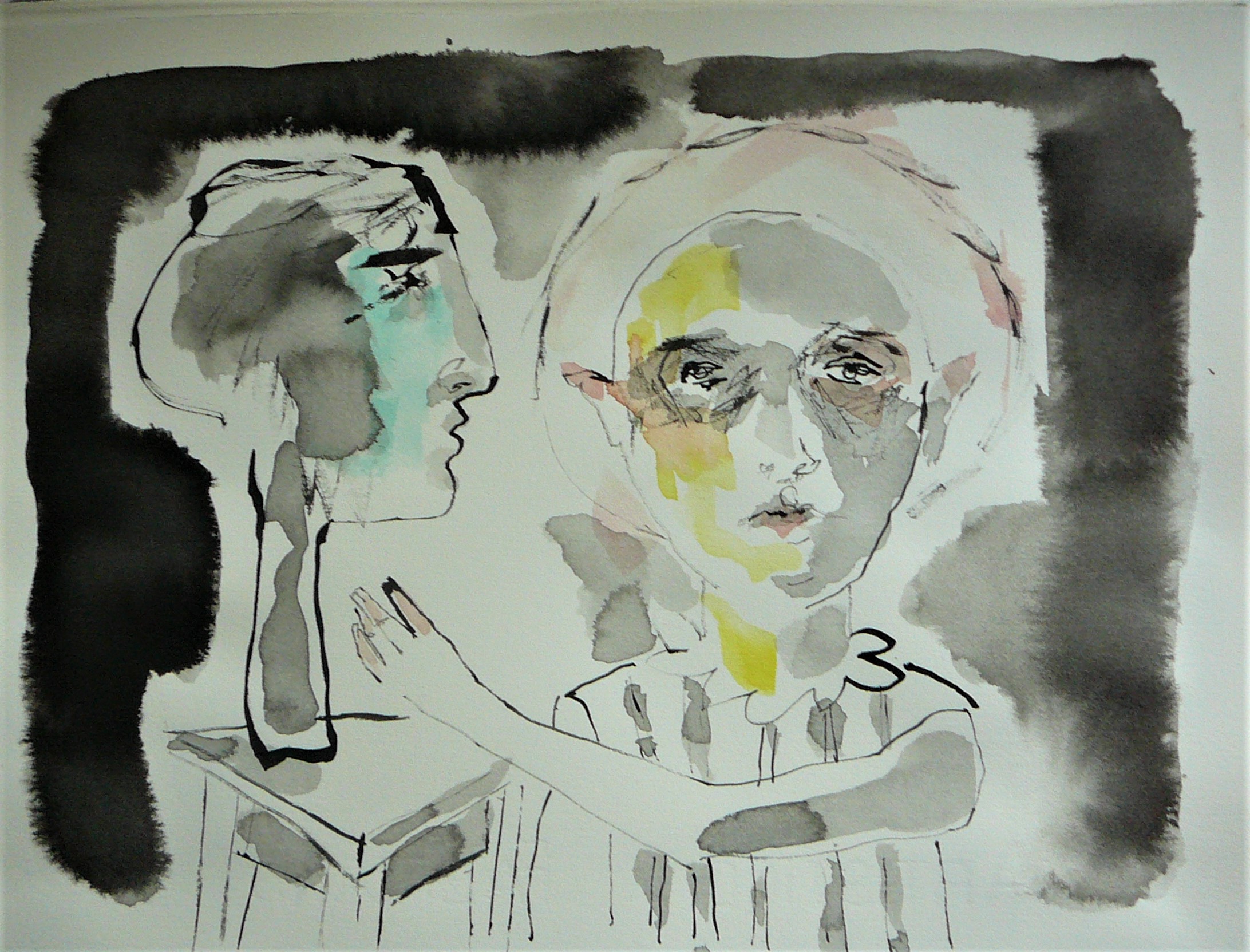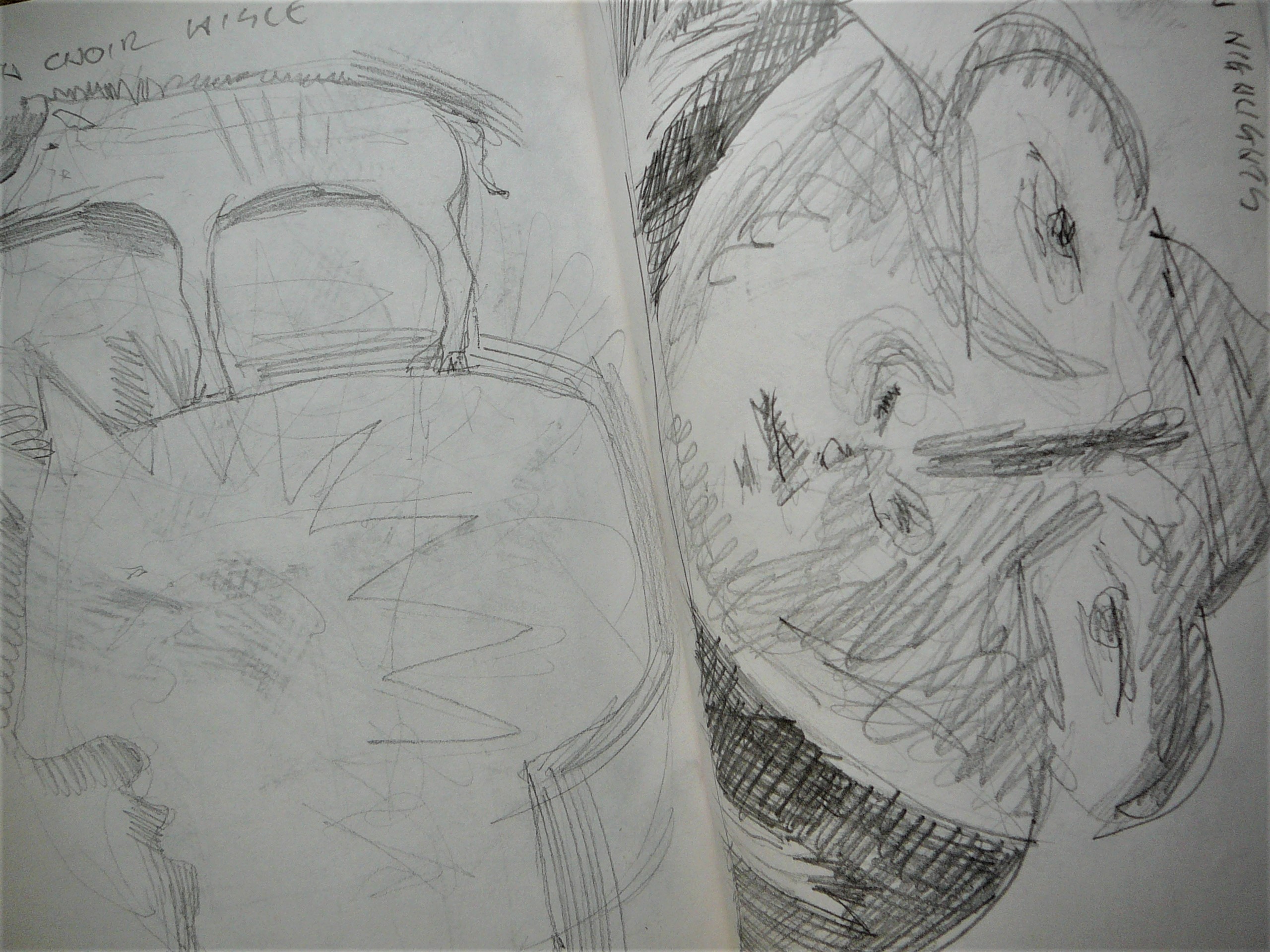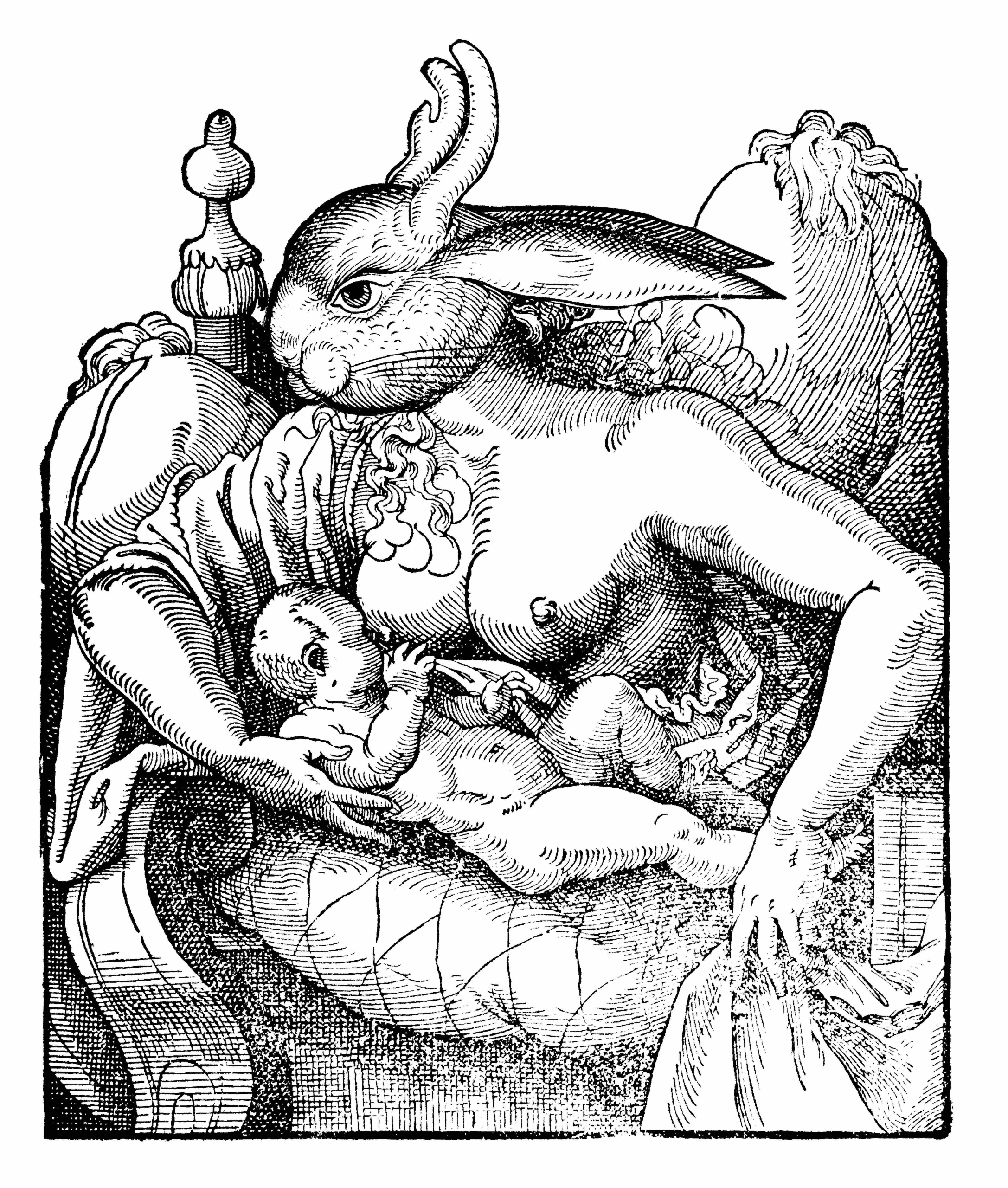Portrait of Keith Bayliss in his studio. Photograph by Bernard Mitchell
In 2008 Keith Bayliss was the first artist invited to exhibit inside St David’s Cathedral as part of the new St David’s Festival. He has had the role of inviting all subsequent artists who show there. His site-specific drawings, paintings and constructions made for that Festival, opened up new directions that he continues to explore. Prior to this opportunity his paintings had more or less respected the formal boundaries of the picture frame even if the life-size or gigantic figures within them were clearly trying to break out. At St David’s, Bayliss made works to fit the apex, trefoil and cinquefoil shapes of cathedral windows and other interior cavities and spaces. This sculptural extension reinforced a tendency hinted at earlier in the woodcut prints made for his book The Children’s Crusade with Old Stile Press. That work, an impeccably handmade album with text provided by Malcolm Parr, took two significant steps. One was towards ‘white’ – away from the slow combustible intensity of green heat, characteristic of his large paintings, and into the albedo or spiritual symbolism of stone and inexorable change. It is no coincidence that many of his luminous drawings also include significant daubs of yellow, confirming the yellow stage – of gold and silver – between darkness and light. These particular figures often wear crowns and diadems of thorns.
The other step taken by that book was that Bayliss’ material committed to the hinged fold. This was an interactive turning point that later literalised as the hinges of doors and windows. This oblique proximity to a stiff, unyielding lid more than contradicts the nakedness of Bayliss’ humanoid figures. There is little pliable cloth in any of the works. Lines are bold, broad and formidable. In the constructions boundaries are even stronger – yet still they open up, still they release their interior.
Returning to colour, Bayliss has a deeply intuitive grasp of symbolism and of restraint. He frequently deploys auxiliary ochres when mainly green monochromes occupy canvasses showing figures in isolation, at the threshold of dreadful insight or crawling through doorways on their hands and knees. Even the use of occasional brighter colours – scarlets and blues – remains minimal and remind us of mycelial or fungoid tones. They have the attributes of another, alien form of life, one that is always nearby, enchanting, but not always desirable.
Then suddenly at his Mission Gallery exhibit in Swansea in February/March 2012 something transforms Keith Bayliss’ art. The subject material becomes another entity altogether. There are two very large, characteristic canThe paintings of Keith Bayliss are inhabited by figures that look a lot like people but instantly we ask ourselves, what kind of people are they? They have huge heads, beseeching hands and they are almost always green. They may not look like you and I but their emotional intensity makes them look a lot like we might often feel. Bayliss depicts the human form in ways instantly recognisable as embodying shock, wonder, reflection and the wounds of a thoughtful life. His figures are naked – not shielded by props, not wrapped in shawls and not (usually) protected by clothing. The nudity of his men, women and children, both proud and vulnerable, is made all the more compelling, fascinating and unapproachable by the earthy pigments Bayliss used to colour them.
His figures are the colour of dark Verdigris – the uneven patina that forms on copper and brass, the slow, noble rust that both attacks and protects the surface of bronze. His figures bear other signs of innocent dignity – the nose bridges directly from the forehead, eyes expand towards the temple and lips are sealed and serious or open as if to sing. The face is important to Keith Bayliss and many figures do not bother with a cranium at all. When they do, the full size head is so enormous that a naked body buckles in order for the composition to fold and fit within the frame. Bayliss’ people are the colour of lichen and moss and appear to be every bit as slow moving. Even when extending their arms, throwing an inward gaze beyond their confining cage or tentatively patting their cheeks as if to confirm they’re real, physical movement is both languid and decisive, the way that lichen firmly occupies wood or stone with fragile, tenebrous determination.
Paintings have titles such as The Visitor – Love, Things of the Earth, Things of the Air, White Angel and Two Souls. There is no denying the mortal, spiritual or elemental dimension. Bayliss’ imagination is alchemical without resorting to the more lurid templates of that secretive tradition. His paintings are not so mysterious. Their codes are literal, generous, candid – a head or face sprouting petals or wings is clearly a loving, bounteous cherub, Horsewoman has a horse’s tail. Bayliss’ alchemy is that of love, male and female, the conjunction and separation of souls. His ingredients are the burgeoning forces of spring with a simultaneous consciousness of decay; nudity – the most obvious semiotic of male and female; puckish, human figures frozen in ponderous activity. There is plenty of paradox. Bayliss, by training, inclination, and confession is strongly influenced by the art of classical Greece – which includes presenting characters as ideals, unfinished, in fragments or as beautiful survivors with amputations. His technical heroes are Rembrandt and Goya. Canvasses facing each other – embryonic, enigmatic, imposing, majestic, gloomy and funereal, The colours are aloof, but are those of the low exposed roots of trees in a deep dark wood. The subjects are human figures inhabiting the reduced settings of curve, moonlight, cloisters, doorways, night and separation that Bayliss prefers. Huge heads squeeze into the cusp of arched windows and another figure laments over a body sketched in a suggested coffin.
Between these massive, sombre panels, the floor of the gallery has become a numinous, almost empty space – it was once a Seamans’ Mission, (St Nicholas’ Church) built in 1886. Here, the artist has set two human creatures moulded from tissue paper, lifted from now discarded ceramic shells. Their fragility, as Clive Hicks Jenkins said in his remarks, is palpable. ‘Their faces are brimming with humanity’. Other fragmented beings, sometimes simply a trinity of arms offering rosy faces in their outstretched hands, burst through high, opening windows, relics of the original building transfigured into the foundations of something new. Our interior becomes their exterior. These creatures aren’t peeking out, they are hatching from the covers of confinement – wooden tongue and groove shutters that Bayliss has made and painted the colour of red soil. These visitors, actors, dolls, mannequins, these homunculi, are not the bruised blue of newborn beings but the ruddy rubedo of toddlers, roses with the blush of virgins and inexperience. They are daimons in the ancient sense, muses eagerly entering a now secularised space redeemed by the brief inspiring moment of Bayliss’ stewardship.
One commentator observes that we might consider visiting the gallery a second time. Return, he advises when the gallery is as empty as places of contemporary worship normally are these days and appreciate the show in silence. This observation fills me with melancholy, as if the best church is a deserted one, whereas there we were, disturbing these timeless and ephemeral angels with our arts’ reception wine and chatter.
In the centre of the gallery these two figures remain– both without arms. He hovering above a ‘table’ she, standing in a ‘boat’ as if sailing forward. He has a gold-lined bowl on his head. She has a twig-bearing dove on hers. She has golden nipples. He has a golden penis. They were made for each other. They are clearly contrasexual – he is domestic, she is in the world. If he is a hunter, then he has a gatherer’s bowl on his head. If she is a mother or a wife – the collection of hearts within her unfinished boat is raw, paradoxical and unsettling.
Detail from Hortus Conclusus, Mission Gallery 2012
The reverential attention these figures received was astonishing and the figure of the female was quickly sold. What the fate of this sculpture will be, I don’t know. But I do know that the sense of life imparted to these diminutive forms created a breathtaking aura that had experienced gallery visitors both lost for words and chattering excitedly as they responded to her manifest beauty and his equally extraordinary sense of balance, poise and exposure.
Keith Bayliss has now produced a body of work that if, because of its slow, pullulating colours of sublime but mired endurance and renewal, was once considered difficult – must now be reassessed. All along his work has been sacramental. His pigments and daubs carry the banner of Gaia as much as eco-angst and contemplative love. Devotion like this, in a period of spiritual embarrassment, is often ungainly. Keith Bayliss’ art is therefore also heroic and chivalrous in that it has a sense of Quixotic scale but is not impulsive – contradictions that resolve themselves in the complexities of his unflinching quest.
David Greenslade,
Writer and Poet
2012



